[English] 日本語
 Yorodumi
Yorodumi- PDB-2m1k: Interaction of Human S100A6 (C3S) with V domain of Receptor for A... -
+ Open data
Open data
- Basic information
Basic information
| Entry | Database: PDB / ID: 2m1k | ||||||
|---|---|---|---|---|---|---|---|
| Title | Interaction of Human S100A6 (C3S) with V domain of Receptor for Advanced Glycation End products (RAGE) | ||||||
 Components Components |
| ||||||
 Keywords Keywords | PROTEIN BINDING / S100A6 C3S / RAGE V / heterotetrameric / HADDOCK model | ||||||
| Function / homology |  Function and homology information Function and homology informationadvanced glycation end-product receptor activity / negative regulation of blood circulation / positive regulation of endothelin production / regulation of CD4-positive, alpha-beta T cell activation / glucose mediated signaling pathway / positive regulation of monocyte extravasation / regulation of T cell mediated cytotoxicity / positive regulation of DNA-templated DNA replication / negative regulation of long-term synaptic depression / positive regulation of dendritic cell differentiation ...advanced glycation end-product receptor activity / negative regulation of blood circulation / positive regulation of endothelin production / regulation of CD4-positive, alpha-beta T cell activation / glucose mediated signaling pathway / positive regulation of monocyte extravasation / regulation of T cell mediated cytotoxicity / positive regulation of DNA-templated DNA replication / negative regulation of long-term synaptic depression / positive regulation of dendritic cell differentiation / regulation of p38MAPK cascade / monoatomic ion transmembrane transporter activity / regulation of non-canonical NF-kappaB signal transduction / positive regulation of amyloid precursor protein catabolic process / transcytosis / induction of positive chemotaxis / positive regulation of heterotypic cell-cell adhesion / positive regulation of monocyte chemotactic protein-1 production / S100 protein binding / positive regulation of p38MAPK cascade / regulation of long-term synaptic potentiation / protein localization to membrane / regulation of spontaneous synaptic transmission / negative regulation of connective tissue replacement involved in inflammatory response wound healing / scavenger receptor activity / laminin receptor activity / negative regulation of interleukin-10 production / positive regulation of double-strand break repair / tropomyosin binding / positive regulation of activated T cell proliferation / response to amyloid-beta / TRAF6 mediated NF-kB activation / Advanced glycosylation endproduct receptor signaling / negative regulation of long-term synaptic potentiation / phagocytosis / phagocytic cup / transport across blood-brain barrier / positive regulation of chemokine production / ruffle / positive regulation of interleukin-12 production / astrocyte activation / axonogenesis / positive regulation of interleukin-1 beta production / positive regulation of JNK cascade / microglial cell activation / positive regulation of non-canonical NF-kappaB signal transduction / positive regulation of NF-kappaB transcription factor activity / TAK1-dependent IKK and NF-kappa-B activation / regulation of synaptic plasticity / positive regulation of interleukin-6 production / response to wounding / cytoplasmic side of plasma membrane / fibrillar center / positive regulation of fibroblast proliferation / cellular response to amyloid-beta / neuron projection development / positive regulation of tumor necrosis factor production / calcium-dependent protein binding / cell junction / transmembrane signaling receptor activity / nuclear envelope / signaling receptor activity / : / amyloid-beta binding / regulation of inflammatory response / histone binding / molecular adaptor activity / learning or memory / early endosome / response to hypoxia / cell surface receptor signaling pathway / positive regulation of ERK1 and ERK2 cascade / postsynapse / apical plasma membrane / inflammatory response / calcium ion binding / protein-containing complex binding / perinuclear region of cytoplasm / cell surface / signal transduction / protein homodimerization activity / DNA binding / RNA binding / extracellular exosome / extracellular region / zinc ion binding / identical protein binding / nucleus / plasma membrane / cytoplasm / cytosol Similarity search - Function | ||||||
| Biological species |  Homo sapiens (human) Homo sapiens (human) | ||||||
| Method | SOLUTION NMR / simulated annealing | ||||||
 Authors Authors | Gupta, A.A. / Yu, C. | ||||||
 Citation Citation |  Journal: Biochem.Biophys.Res.Commun. / Year: 2013 Journal: Biochem.Biophys.Res.Commun. / Year: 2013Title: Interaction of the S100A6 mutant (C3S) with the V domain of the receptor for advanced glycation end products (RAGE). Authors: Mohan, S.K. / Gupta, A.A. / Yu, C. | ||||||
| History |
|
- Structure visualization
Structure visualization
| Structure viewer | Molecule:  Molmil Molmil Jmol/JSmol Jmol/JSmol |
|---|
- Downloads & links
Downloads & links
- Download
Download
| PDBx/mmCIF format |  2m1k.cif.gz 2m1k.cif.gz | 2.5 MB | Display |  PDBx/mmCIF format PDBx/mmCIF format |
|---|---|---|---|---|
| PDB format |  pdb2m1k.ent.gz pdb2m1k.ent.gz | 2.2 MB | Display |  PDB format PDB format |
| PDBx/mmJSON format |  2m1k.json.gz 2m1k.json.gz | Tree view |  PDBx/mmJSON format PDBx/mmJSON format | |
| Others |  Other downloads Other downloads |
-Validation report
| Summary document |  2m1k_validation.pdf.gz 2m1k_validation.pdf.gz | 532.1 KB | Display |  wwPDB validaton report wwPDB validaton report |
|---|---|---|---|---|
| Full document |  2m1k_full_validation.pdf.gz 2m1k_full_validation.pdf.gz | 887.7 KB | Display | |
| Data in XML |  2m1k_validation.xml.gz 2m1k_validation.xml.gz | 133.2 KB | Display | |
| Data in CIF |  2m1k_validation.cif.gz 2m1k_validation.cif.gz | 180.3 KB | Display | |
| Arichive directory |  https://data.pdbj.org/pub/pdb/validation_reports/m1/2m1k https://data.pdbj.org/pub/pdb/validation_reports/m1/2m1k ftp://data.pdbj.org/pub/pdb/validation_reports/m1/2m1k ftp://data.pdbj.org/pub/pdb/validation_reports/m1/2m1k | HTTPS FTP |
-Related structure data
| Related structure data | |
|---|---|
| Similar structure data | |
| Other databases |
- Links
Links
- Assembly
Assembly
| Deposited unit | 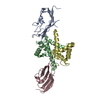
| |||||||||
|---|---|---|---|---|---|---|---|---|---|---|
| 1 |
| |||||||||
| NMR ensembles |
|
- Components
Components
| #1: Protein | Mass: 10177.664 Da / Num. of mol.: 2 / Mutation: C3S Source method: isolated from a genetically manipulated source Source: (gene. exp.)  Homo sapiens (human) / Gene: CACY, S100A6 / Plasmid: pET(20b)+ / Production host: Homo sapiens (human) / Gene: CACY, S100A6 / Plasmid: pET(20b)+ / Production host:  #2: Protein | Mass: 11217.007 Da / Num. of mol.: 2 / Fragment: UNP residues 23-121 Source method: isolated from a genetically manipulated source Source: (gene. exp.)  Homo sapiens (human) / Gene: AGER, RAGE / Plasmid: pET(15b)+ / Production host: Homo sapiens (human) / Gene: AGER, RAGE / Plasmid: pET(15b)+ / Production host:  Has protein modification | Y | |
|---|
-Experimental details
-Experiment
| Experiment | Method: SOLUTION NMR Details: Interaction of Human S100A6 (C3S) with V domain of Receptor for Advanced Glycation End products | ||||||||||||||||||||||||||||||||
|---|---|---|---|---|---|---|---|---|---|---|---|---|---|---|---|---|---|---|---|---|---|---|---|---|---|---|---|---|---|---|---|---|---|
| NMR experiment |
|
- Sample preparation
Sample preparation
| Details | Contents: 1.0 mM [U-100% 13C; U-100% 15N] S100A6 C3S, 20 mM TRIS, 10 mM Calcium chloride, 0.01 % sodium azide, 90% H2O/10% D2O Solvent system: 90% H2O/10% D2O | ||||||||||||||||||||
|---|---|---|---|---|---|---|---|---|---|---|---|---|---|---|---|---|---|---|---|---|---|
| Sample |
| ||||||||||||||||||||
| Sample conditions | Ionic strength: 0 / pH: 7 / Pressure: ambient / Temperature: 298 K |
-NMR measurement
| NMR spectrometer | Type: Varian INOVA / Manufacturer: Varian / Model: INOVA / Field strength: 700 MHz |
|---|
- Processing
Processing
| NMR software |
| ||||||||||||||||||||||||||||||||
|---|---|---|---|---|---|---|---|---|---|---|---|---|---|---|---|---|---|---|---|---|---|---|---|---|---|---|---|---|---|---|---|---|---|
| Refinement | Method: simulated annealing / Software ordinal: 1 Details: HADDOCK STARTING STRUCTURES ARE PDB ENTRIES 1K9K AND 2E5E. MODELS 1-10 ARE SUPERIMPOSED, WHILE MODELS 11-20 ARE SUPERIMPOSED IN A DIFFERENT ORIENTATION. | ||||||||||||||||||||||||||||||||
| NMR representative | Selection criteria: lowest energy | ||||||||||||||||||||||||||||||||
| NMR ensemble | Conformer selection criteria: structures with the lowest energy Conformers calculated total number: 200 / Conformers submitted total number: 20 / Representative conformer: 1 |
 Movie
Movie Controller
Controller




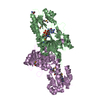
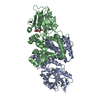
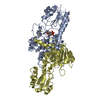
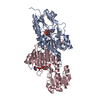
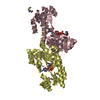
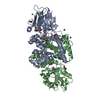
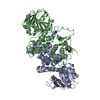
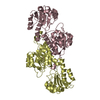
 PDBj
PDBj









 HSQC
HSQC